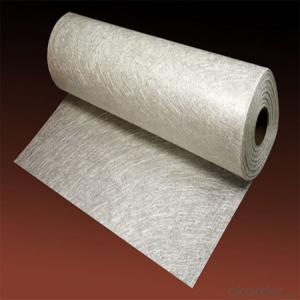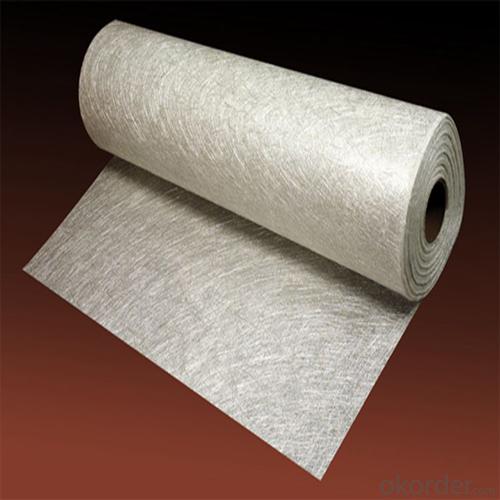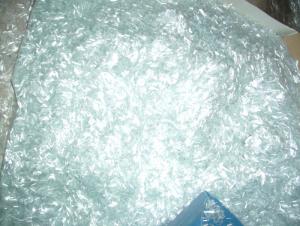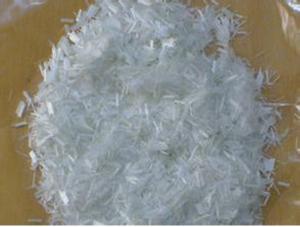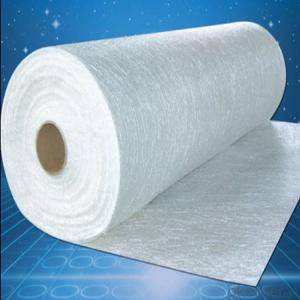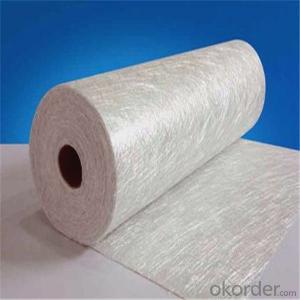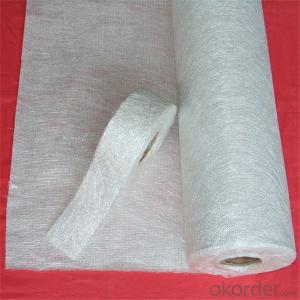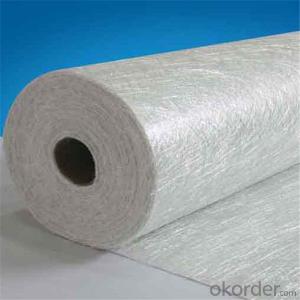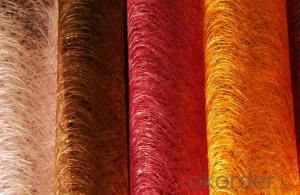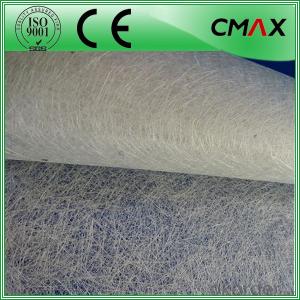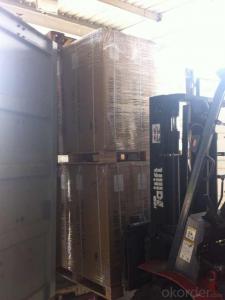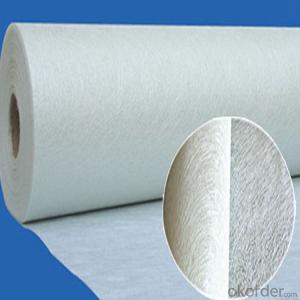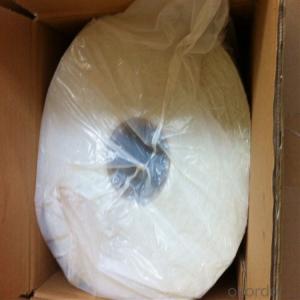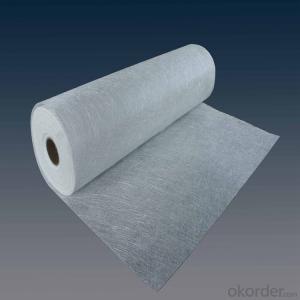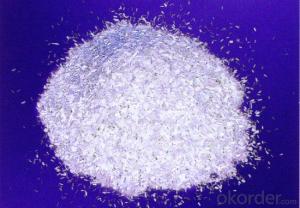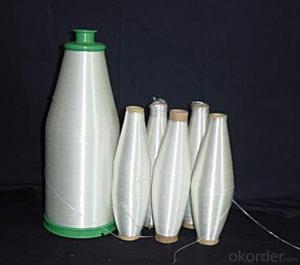Fiberglass Chopped Strand Insulation Material Fiber Glass Chopped Strand Mat
- Loading Port:
- China main port
- Payment Terms:
- TT OR LC
- Min Order Qty:
- 1 kg
- Supply Capability:
- 5000 kg/month
OKorder Service Pledge
OKorder Financial Service
You Might Also Like
Product Description:
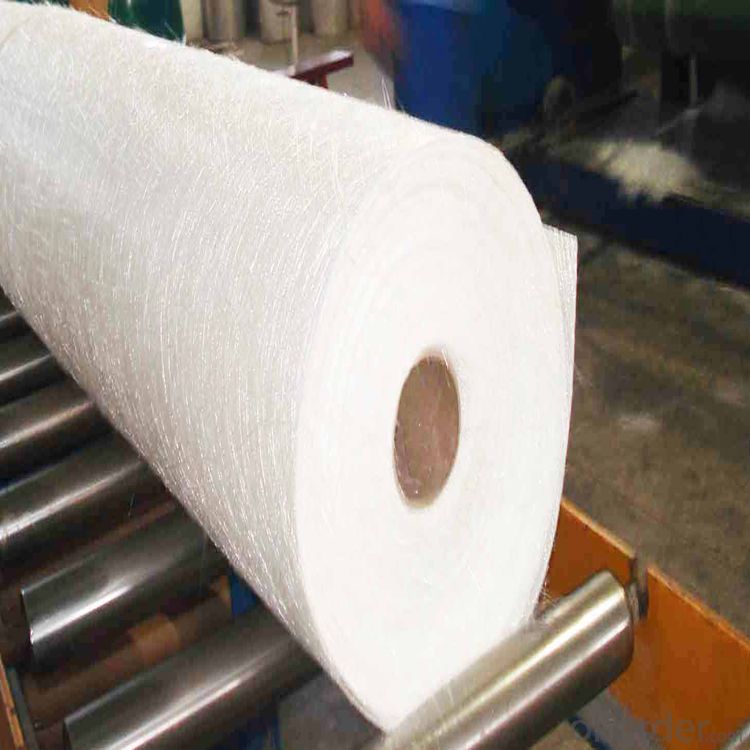
Surfacing Tissue mainly used in the surface layers of FRP products. It features even Fiber distribution, soft feel, level and smooth fiber surface, less glue content, quick resin soak and good pattern fitness. It can improve the product surface property on corrosion resistance, compressive strength, seepage resistance, and longer service life. It is also suitable for spraying; pattern pressing and other FRP pattern technology.
Surfacing Tissue mainly used in the surface layers of FRP products. It features even Fiber distribution, soft feel, level and smooth fiber surface, less glue content, quick resin soak and good pattern fitness. It can improve the product surface property on corrosion resistance, compressive strength, seepage resistance, and longer service life. It is also suitable for spraying; pattern pressing and other FRP pattern technology.
Product Features:
Fast breakdown in styrene
Fiber dispersed evenly
Low binder content
Superior acid corrosion resistance
Specifications:
Item | Over Density | Moisture Content | Chop Density | Polyester Yarn | Width |
(g/m2) | (%) | (g/m2) | (g/m2) | (mm) | |
EMK300 | 309.5 | ≤0.15 | 300 | 9.5 | 50-3300 |
EMK380 | 399 | 380 | 19 | ||
EMK450 | 459.5 | 450 | 9.5 | ||
EMK450 | 469 | 450 | 19 | ||
EMC0020 | 620.9 | 601.9 | 19 | ||
EMC0030 | 909.5 | 900 | 9.5 |
Product Packaging:
Each Surface Tissue is wound onto a paper tube which has an inside diameter of 76mm and the mat roll has a diameter of 330mm. The mat roll is wrapped up with plastic film,and then packed in a cardboard box or wrapped up with kraft paper. The rolls can be vertically or horizontally placed. For transportation, the rolls can be loaded into a cantainer directly or on pallets.
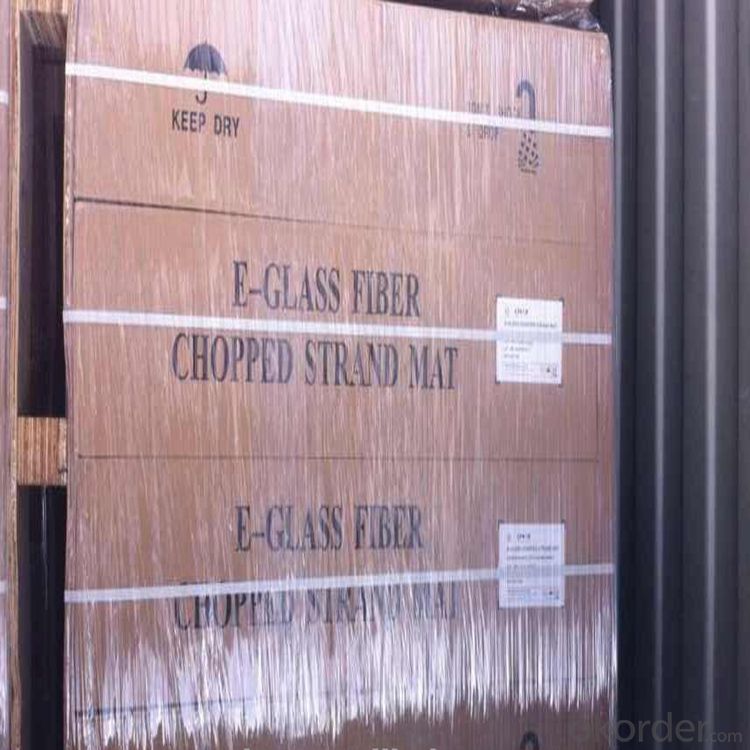
Product Storage:
Unless otherwise specified, Chopped Strand Mat should be stored in a dry, cool and rain-proof area. It is recommended that the room temperature and humidity should be always maintained at 15℃~35℃ and 50%~75% respectively.
Company Information
CNBM (China National Building Material) Group is the largest comprehensive building materials group in China that in integrate scientific research, manufacturing and logistics into one entity. The largest building materials and equipment specialists in China. Upon State Council approval, today CNBM owned more than 300 subordinate manufacturing factories and servicing companies. There are 6 fully owned public listed companies and 11 partially owned with substantial shares public listed companies. In many of these fields, CNBM is playing the leading role in the building industry in the country.
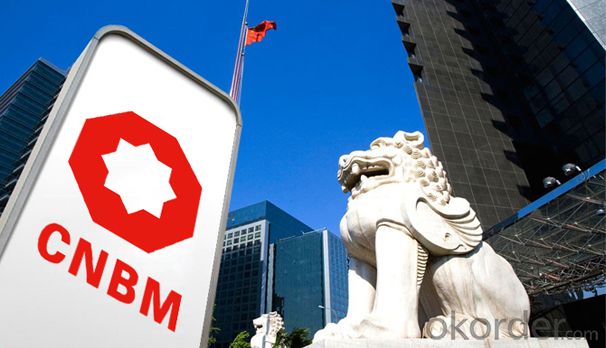
- Q: Does fiberglass chopped strand improve the wear resistance of composite materials?
- Yes, fiberglass chopped strand does improve the wear resistance of composite materials. The fibers help strengthen the composite structure, making it more resistant to wear and abrasion.
- Q: Can fiberglass chopped strand be used in electrical conductive applications?
- Fiberglass chopped strand is not suitable for electrical conductive applications due to its insulating nature. This material does not possess the ability to conduct electricity. It finds its frequent use in applications that demand electrical insulation, such as circuit boards, electrical cables, and insulation barriers. However, if electrical conductivity is desired, it is advisable to opt for materials like copper, aluminum, or other conductive metals.
- Q: How does the fiber diameter affect the performance of chopped strand composites?
- The fiber diameter plays a significant role in determining the performance of chopped strand composites. Firstly, the fiber diameter directly affects the mechanical properties of the composite. Smaller diameter fibers tend to have a higher surface area-to-volume ratio, resulting in better interfacial bonding with the matrix material. This leads to improved load transfer between the fiber and matrix, enhancing the overall strength and stiffness of the composite. On the other hand, larger diameter fibers may have lower surface area-to-volume ratio, leading to weaker bonding and reduced mechanical performance. Secondly, fiber diameter influences the fiber dispersion within the matrix during the manufacturing process. Smaller diameter fibers have a higher tendency to disperse evenly within the matrix, resulting in a more homogeneous composite structure. This leads to improved resistance against crack propagation and better overall structural integrity. Larger diameter fibers, on the other hand, may have a higher tendency to clump together, leading to localized regions of weak bonding and reduced composite performance. Furthermore, the fiber diameter affects the composite's resistance to fatigue and impact. Smaller diameter fibers tend to have higher flexibility and higher strain-to-failure, which makes them more resistant to cyclic loading and impact events. This is particularly important in applications where the composite will be subjected to repetitive or dynamic loading conditions. Larger diameter fibers, due to their lower flexibility, may be more prone to failure under fatigue or impact loading. Lastly, the fiber diameter also influences the composite's thermal and electrical conductivity. Smaller diameter fibers have a higher surface area, allowing for better thermal and electrical conductivity in the composite. This can be advantageous in applications where heat dissipation or electrical conductivity is important. In summary, the fiber diameter significantly affects the performance of chopped strand composites by influencing the mechanical properties, fiber dispersion, resistance to fatigue/impact, and thermal/electrical conductivity. Choosing the appropriate fiber diameter is crucial to optimize the performance of the composite for a specific application.
- Q: How is the abrasion resistance of fiberglass chopped strand composites tested?
- The abrasion resistance of fiberglass chopped strand composites is typically tested using standardized methods such as ASTM D4060 or Taber Abrasion Test. These tests involve subjecting the composite material to abrasive wear by rubbing it against a specified abrasive material under controlled conditions. In the ASTM D4060 test, a rotating wheel with a specific abrasive material is pressed against the surface of the composite sample. The wheel applies a predetermined load and moves in a circular path, causing abrasion on the sample. The test is performed for a specified number of cycles or until a certain level of wear is achieved. The weight loss or change in appearance of the sample is then measured to determine its abrasion resistance. Similarly, the Taber Abrasion Test utilizes a specialized machine that applies a specific type and level of abrasion to the composite material. The sample is mounted on a rotating turntable, and abrasive wheels or disks are pressed against the sample surface while it rotates. The test is performed for a specified number of cycles, and the weight loss or change in appearance of the sample is measured to evaluate its abrasion resistance. Both methods provide quantitative data on the abrasion resistance of fiberglass chopped strand composites, allowing manufacturers and researchers to assess the material's durability and suitability for various applications. These tests help in designing and selecting materials that can withstand wear and provide long-lasting performance in environments where abrasion is a concern, such as automotive components, marine applications, or industrial equipment.
- Q: What are the applications of fiberglass chopped strand?
- Fiberglass chopped strand has a wide range of applications due to its unique physical and mechanical properties. Here are some common applications: 1. Reinforcement in composite materials: Fiberglass chopped strand is extensively used as reinforcement in composite materials such as fiberglass-reinforced plastics (FRP). The strands are mixed with resin to create a strong and lightweight material that is widely used in industries like automotive, aerospace, construction, and marine. 2. Insulation: Fiberglass chopped strand is commonly used as insulation material in various applications. It is an excellent thermal insulator, making it suitable for insulating walls, roofs, pipes, and appliances. Fiberglass insulation also provides soundproofing properties, making it ideal for applications requiring noise reduction. 3. Filtration and separation: The fine fibers of fiberglass chopped strand are often used in filtration and separation processes. They can be manufactured into filter media to remove impurities from air, water, oil, and other fluids. Fiberglass filters are commonly used in HVAC systems, industrial applications, and even in face masks. 4. Electrical insulation: Due to its high dielectric strength and resistance to electrical conductivity, fiberglass chopped strand is widely used as electrical insulation material. It is commonly used in electrical cables, transformers, circuit boards, and other electrical components to protect against electrical current leakage and ensure safety. 5. Reinforcement in concrete: Fiberglass chopped strand is also used as a reinforcement material in concrete structures. It helps increase the strength and durability of concrete, making it suitable for applications like bridges, roads, tunnels, and buildings. Fiberglass-reinforced concrete (FRC) offers enhanced resistance to cracking, impact, and corrosion. 6. Automotive applications: Fiberglass chopped strand is extensively used in the automotive industry for various applications. It is commonly used in the manufacturing of car bodies, interior panels, bumpers, and other components. Its lightweight and high strength properties make it an ideal material for improving fuel efficiency and overall performance. These are just a few examples of the applications of fiberglass chopped strand. Its versatility, durability, and cost-effectiveness make it a preferred choice for various industries and applications.
- Q: Does fiberglass chopped strand have any water absorption properties?
- The absence of water absorption properties characterizes fiberglass chopped strand. This is due to its composition of inorganic materials, like glass fibers, which do not easily soak up water. Moreover, the manufacturing procedure frequently involves the application of binders or coatings that additionally decrease water absorption. Consequently, fiberglass chopped strand finds widespread use in situations necessitating resistance to moisture and water, including boat construction, automotive components, and roofing materials.
- Q: How does the moisture absorption of the chopped strand affect its performance?
- The moisture absorption of chopped strand can significantly affect its performance. Chopped strand, which is typically made of glass or carbon fibers, has a tendency to absorb moisture when exposed to humid or wet environments. This moisture absorption can lead to several negative effects on its performance. Firstly, moisture can weaken the structural integrity of the chopped strand. When the fibers absorb water, they can lose some of their strength and stiffness, which can compromise the overall performance of the material. This can be a major concern in applications where high strength and durability are required, such as in composite materials used in aerospace or automotive industries. Secondly, moisture absorption can lead to dimensional instability. When the fibers absorb water, they can expand, causing the chopped strand to change in size and shape. This can be problematic in applications where precise dimensions are crucial, as it can lead to fitment issues or distortion of the final product. Furthermore, moisture absorption can also lead to the development of mold or fungi. Moisture provides an ideal breeding ground for these organisms, which can degrade the fibers and further compromise the performance of the chopped strand. This can be detrimental in applications where the material is exposed to high humidity or moisture for prolonged periods, such as in marine or outdoor environments. In conclusion, the moisture absorption of chopped strand can have a significant impact on its performance. It can weaken the structural integrity, cause dimensional instability, and promote the growth of mold or fungi. Therefore, it is crucial to consider the moisture absorption characteristics of chopped strand when selecting and using it in various applications.
- Q: How is fiberglass chopped strand incorporated into composite manufacturing processes?
- Fiberglass chopped strand is incorporated into composite manufacturing processes by mixing it with resin to create a reinforced composite material. The chopped strands are evenly distributed throughout the resin, providing strength and reinforcement to the final composite product. This mixture is then molded or laid up in specific shapes or layers and allowed to cure or solidify, resulting in a durable and lightweight composite material.
- Q: How does the abrasion resistance of fiberglass chopped strand compare to other reinforcing materials?
- The abrasion resistance of fiberglass chopped strand is generally considered to be higher compared to other reinforcing materials. This is primarily due to the inherent properties of fiberglass, such as its high tensile strength and durability. Additionally, fiberglass is known for its resistance to wear and tear, making it an excellent choice for applications that require resistance against abrasive forces.
- Q: How does the fiber-matrix adhesion of fiberglass chopped strand affect the performance of composites?
- The overall performance of composites is heavily influenced by the adhesion between the fiberglass chopped strand and the matrix. Several important properties, such as mechanical strength, durability, and resistance to various environmental factors, are directly affected by the adhesion between the fibers and the matrix. To begin with, a robust fiber-matrix adhesion greatly strengthens the composite material mechanically. When there is a strong bond between the matrix and the fibers, stress can be efficiently transferred from the matrix to the fibers, resulting in improved load-bearing capabilities. This adhesion prevents the fibers from slipping or being pulled out of the matrix, thereby increasing the composite's resistance to deformation and enhancing its overall structural integrity. Moreover, a high fiber-matrix adhesion facilitates better energy transfer between the fibers and the matrix, leading to enhanced impact resistance. This is particularly important in applications where the composite is subjected to dynamic loads or impacts, such as in the automotive or aerospace industries. A strong adhesion between the fibers and the matrix allows the composite to absorb and dissipate energy more effectively, reducing the risk of failure or damage. Furthermore, the durability of composites is influenced by the adhesion between the fibers and the matrix. A good adhesion can prevent moisture or other environmental factors from penetrating the interface between the fibers and the matrix, reducing the risk of delamination or degradation. This ensures that the composite retains its properties over an extended period, making it suitable for long-term applications. Additionally, the fiber-matrix adhesion plays a role in the composite's resistance to various chemicals and corrosion. A strong bond between the fibers and the matrix can prevent chemical substances from penetrating the interface and causing damage to the composite. This enables the material to withstand exposure to harsh chemicals, acids, or alkalis, making it suitable for applications in corrosive environments. In conclusion, the fiber-matrix adhesion of fiberglass chopped strand has a significant impact on the performance of composites. A strong adhesion enhances the mechanical strength, impact resistance, durability, and resistance to chemicals and corrosion. Therefore, it is crucial to optimize the fiber-matrix adhesion in order to maximize the performance and reliability of composite materials.
Send your message to us
Fiberglass Chopped Strand Insulation Material Fiber Glass Chopped Strand Mat
- Loading Port:
- China main port
- Payment Terms:
- TT OR LC
- Min Order Qty:
- 1 kg
- Supply Capability:
- 5000 kg/month
OKorder Service Pledge
OKorder Financial Service
Similar products
Hot products
Hot Searches
Related keywords
